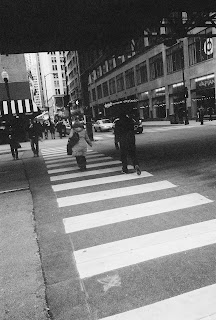If you guessed it's the M4-2 with a Hexanon 35mm lens... you have a good eye! It also helps that this is the view of the Ayuntamiento de Toledo, during a time there was an art installation in town that was supposed to do precisely what I managed to photograph: a reflection. I have no idea about the exposure, but I feel kinda proud of it.
Now... let's move onto something else.
This is the street where I live, on a very foggy fall day. The camera... is a challenge now, but suffice it to say it's not any of my Leicas but the Nikon S2 with its 50mm f1.4 lens. I no longer do much in color since the only reliable lab (oddly enough, in Walgreen's) closed shop. I probably would have tried to keep it in business, but the corporate forces chose to remove it from our midst. However, one never knows... I may try to do some photographs in slower film like Ektar, instead of the usual Kodak or Fuji ISO 400 (used here).
For another challenge, let's take a peek at this one:
Experience has taught me how to meter in cases like the one above: for the effect I wanted (strong contrasts), I metered for the highlights. And the camera... is one Leica M4, fitted with a Summicron 50mm. Mimi, one of our cats, likes taking in the sunrays right at the entrance door of the house, and that's what she was doing at the moment of taking this photograph. Kind of domestic poetry... or prosaic bliss...
BTW, the camera used above is now in California, in the hands of another photographer that will take care of it better than I did. Now, however, I do have yet another M4, as announced in a post below. It came in late May, and I used it to make the images below (with a Summilux 35mm or a Summicron 50mm)...
Chairs in Fürther Strasse, Nürnberg (Leica M4, Summicron 50mm)
Entrance to Metro Station, Nürnberg (Leica M4, Summicron 50mm)
Splitting Logs, Viking style, Roskilde, Denmark (Leica M4, Summilux 35mm)
Bärenschance Metro Station Stairs, Nürnberg (Leica M4, Summilux 35mm)
The biggest difference in the way the images right above were made, compared to the earlier ones, is that I decided to change film speed, and use Arista ISO 100 instead. Now, I did something quite risky, which was take all my stock of new film in a trip, without testing anything first. Hence, I had no idea about how it would react to my sometimes bad metering, or whether it'd be tolerant to over- or under- exposure. For all practical purposes, the only ISO 400 film I took with was an old roll of HP5 that I promptly burned in the first stage of our trip, Copenhagen. All in all, when I saw the results, I was very pleased. Not only that, I intend to stay with ISO 100 film for as long as I can before I choose something else.
One final note: I didn't develop the last four photographs (something I had intended to do). Instead, I sent them to a place called The Darkroom, all the way in California. Judging from the results, I can recommend most enthusiastically. They do a nice and careful job with your photographs.
Soon enough, some gear porn. I have now my Leica M2, in addition to a new(ish) Leica M4 (which I had to re-cover, as the leatherette was old enough to crack on me during our trip), and a nice Konica 90mm f2.8 lens. This will be the last glass I ever buy! In fact, I'm contemplating a couple of sales... but I won't bore anyone with that. Stay cool if you're hot, and warm if you're cold!













































